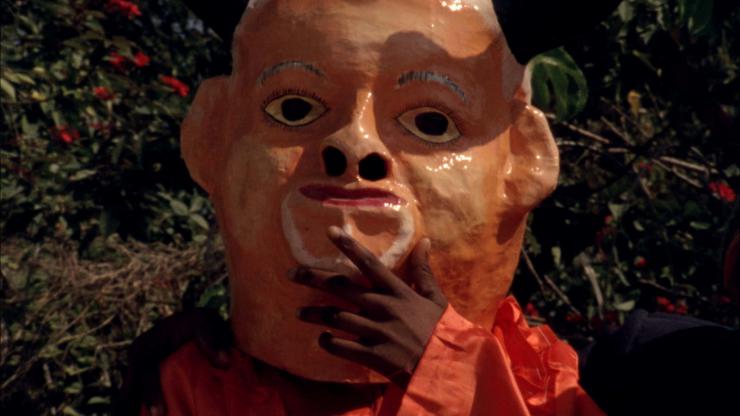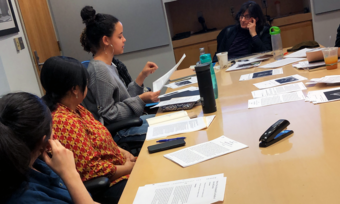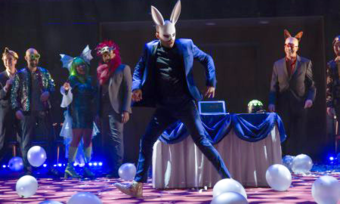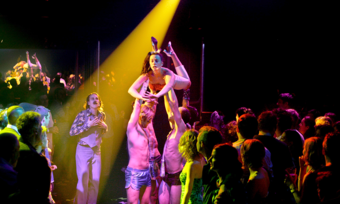Film As Live Art
Gabriel Abrantes and Theatrical Gesture
Three works of the Lisbon-based filmmaker Gabriel Abrantes were shown at the MIT List Center throughout May and June. All three are worth something, but I want to concentrate here on one piece in particular. Do not be alarmed, but note that the piece was not live: it is a film. A view on it belongs here because I believe its success has bearing on the practice of live art, and offers strategic recommendations that I’d like to draw your attention to.
’´Oρνιθες was shot in Jakmel, Haiti, where Abrantes staged a production of Aristophanes’ The Birds in the original Attic Greek with local performers and costumes contributed by local artisans. Clocking at eighteen minutes, the resultant video obviously does not include the entirety of the production. What it does include is a sense of an event that the production creates in broad ripples through a community: around the clip we see of the play is a document that places the event on a symbolic register of geopolitical and historic significance.
That kind of stuff is what we really want to know about. Theatre artists can talk a lot about how important it is that theatre is live, that human presence is involved with what it does, and so on. But with a reachable community as large as the globe, I submit that we’ve become slightly baffled. If presence is what’s important, we have to insist that anybody who couldn’t see the play in person can’t really know much about it, at least in the auratic way centered on presence that we so want to insist is the one that counts. But artists will naturally want the broadest reach possible, and it is tricky to think about how a little experimental production can really be involved with the large and important dialogues of a global society while keeping to the principle of live coexistence. Any comment on issues larger than the very local community the play actually serves begins to feel strained and artificial.
Theatre artists can talk a lot about how important it is that theatre is live, that human presence is involved with what it does, and so on. But with a reachable community as large as the globe, I submit that we’ve become slightly baffled. If presence is what’s important, we have to insist that anybody who couldn’t see the play in person can’t really know much about it, at least in the auratic way centered on presence that we so want to insist is the one that counts.

One can shy away from this problem by using recorded media as a promotional tool, or offering streaming video of a little fringe show as a second-string option. But video always compromises the look and feel of three-dimensional space, and much web-promotion has the feel of TV commercials: it is a teaser before you buy a ticket. Otherwise it becomes a resource for a few fanatics who are passionately interested in the subject your play deals in from Nova Scotia, or wherever. This is fine, but it is not perfect. A recorded scene from a piece of theatre might help a touring company to drive up ticket sales, but a recorded play will not include any really articulate sense of site and atmosphere that good fringe theatre might activate, except perhaps for the specialist. If you are a small company, why make the compromise of documenting around something that can’t be preserved? Video becomes a frustratingly imperfect window, all the more frustrating because a tantalizing global community that theatre artists rarely reach seems to lie on its other side.
But Gabriel Abrantes uses this system of issues to his advantage. Textures of interference between local and global culture haunt his films, and ’´Oρνιθες in particular. In ways, the film is a document of a theatrical production. But the play is classic: we know how it goes, more or less, and if we do not know we can look it up. A brief glimpse of the production (probably three minutes long) gives a sense of the piece: the sound of choral speech in Attic Greek, the bright wooden costumes and masks, and the dilapidated façade of the Hotel Communal where it took place. This is all we see or hear of the play itself.
But what surrounds this episode cradles the play the way classic dramatic structure cradles spectacular choral song sequences in Greek drama. By focusing on surrounding context, the strange local event that was Abrantes’ production becomes itself a kind of dramatic moment inscribed on history, conscious of (though never making reference to) the destruction wreaked on Jakmel by a devastating magnitude 7.0 earthquake in 2010, just two years prior to filming. Remembering Greek drama as a cathartic—so therapeutic—form, one wants to notice that Abrantes places a Greek play in a location where an entire populace has been touched by a force as destructive as Peloponnesian war, as Athenian society would have been during the heyday of the Dionysia. How much this frame actually had to do with the madcap and carnivalesque show is of course debatable, and the of course the parallel never even mentioned in the film.
For ’´Oρνιθες is not didactic. Here documentation of the play becomes more than document: it indicates the event itself as a locus of aesthetic interest. Rather than a recording of the entirety of a play (which we all know misses something, and is boring to watch) we have a synthesized atmosphere of how a play happened. This includes all sorts of things: the promotion by loudspeaker from a car with a hand-painted sign, the personal experiences of the girls from the next village who came with chickens to be an audience, a wild story from a man in the woods who hasn’t participated at all, at least in the traditional sense. All this gives a texture of inclusion that is as close to the obscure force of performance as a static document can touch. That a play has happened becomes the strangest and most fascinating thing.
In ways, the method is not new: there are plenty of old Hollywood movies about theatre—there is even some fantasy in my subconscious of an actor like Mickey Rooney who wants to raise money to save the high school prom saying, “I know, fellas, let’s put on a show!” Abrantes, if he draws on this popular vision of the movie-about-a-play, brushes but does not embrace it. For one thing, we never hear from anybody who is actually participating, never even see them out of costume or up close: we see one actor in a green bird-suit from the car that follows his moped, and later watch him ride a horse into a shallow creek, going for a dip. “He’s cuter than Robert Pattinson,” says one of the girls who has come to town for the show. This is particularly funny because he’s wearing a mask.
But fandom and sex appeal are important aspects of performance. “With a distinct theatricality and politicized focus, Lisbon-based filmmaker Gabriel Abrantes . . . crafts fictions around the new identities and relations of desire forged through globalization.” So begins the note provided by the List Center. Desire, in ’´Oρνιθες, is involved with theatricality; we are interested in the play not least because the young girls were interested, not least because they are excited enough to say from the outset that it’s going to be better than Twilight. Viewership is caught up with desire. The transposition of desire from the vampiric Hollywood marketplace onto a local, human scale is one of the threads Abrantes pulls.
Another is mystery. We do not see much of this production, but we hear a lot about it. We see the promotional car, driving through the village, announcing by loudspeaker the most memorable spectacle imaginable, and the free glass of booze that comes with paid admission—or if you can’t manage the cost of admission, bring a chicken to throw on the fire. “Little Gabriel Abrantes directs, risking his reputation!” There is curmudgeonly commentary, complaining that comic dactyls and choral hexameter won’t necessarily induce a Dionysiac trance state the way the director seems to think they will, and these are really just kids jumping around in animal costumes, thinking they’re performing some kind of protest.
But all this has an effect like suspense: we get the feeling we do not know what the play was actually like, and for the brief scene that is included, one is almost too shocked by the sudden cacophony and theatricality to think of anything that it might protest, anything that it might mean apart from its own weird richness. All of a sudden the scene is over, and by the film’s end we’re left with strange fascination. Not, as so often happens with recordings of drama, boredom. What we have irrevocably missed, we are reminded that we cannot see. But what this serves, if not the entire length of the play, is its auratic quality. We give up factual record for a reason: the preservation of magic.









Comments
The article is just the start of the conversation—we want to know what you think about this subject, too! HowlRound is a space for knowledge-sharing, and we welcome spirited, thoughtful, and on-topic dialogue. Find our full comments policy here